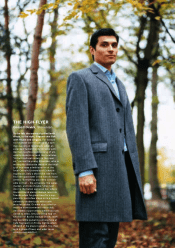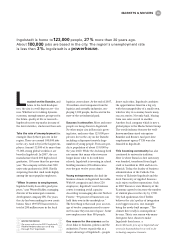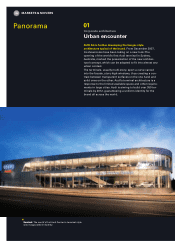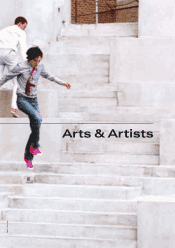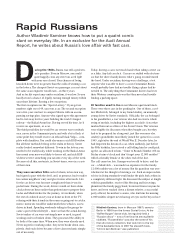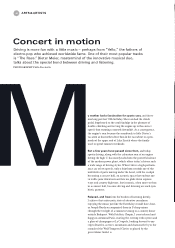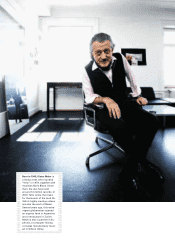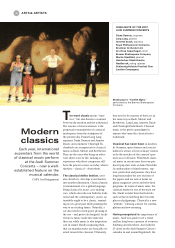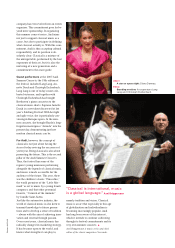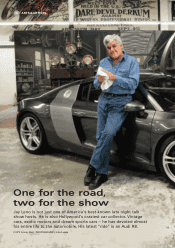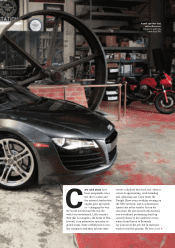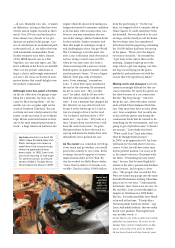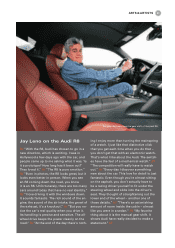Audi 2007 Annual Report Download - page 44
Download and view the complete annual report
Please find page 44 of the 2007 Audi annual report below. You can navigate through the pages in the report by either clicking on the pages listed below, or by using the keyword search tool below to find specific information within the annual report.
life. On Friday, clutching a sports bag containing 12,000 rou-
bles, Andrej and I went to the car dealership near Moscow’s
south railway station. Taking delivery of the car lasted an en-
tire day. From 50 (!) different cars on display at the dealership,
we chose one that actually ran. It was bright yellow, and a slip
of paper on the trunk read “Banana” – probably the official
name of its color. In any case, from that time on, we only ever
called it Banana.
The cash was handed over the counter and was carefully
counted out. Our Banana adventure was about to begin. First
we had to visit the licensing bureau, the garage, and the po-
lice. And the 12,000 roubles didn’t quite cover it all: We had to
give the salesman a five-rouble note so we could take it for a
test drive. Then another five-rouble note was needed at the
door of the licensing center, that had “closed just a minute
ago.” But at the sight of the banknote, the door opened, anoth-
er five-rouble note and the engineer, who had allegedly “just
gone on lunch hour,” was willing to postpone his break for an
hour. Yet another five roubles, and a technician explained to us
what needed replacing immediately on our brand-new, care-
fully selected car (with a year’s state warranty) and what parts
could wait. Fuel tank, gearbox, front-wheel suspension: One
third of our yellow Moskvitch was repaired the very first day.
Having suspected this might happen, Andrej had
brought a wad of five-rouble notes with him. At the end of the
day, that was gone, but we did get to take the Banana for a
moonlight dip in a Moscow lake. We sped through the city do-
ing 140 kilometers per hour (kph) and with the windows open,
pointed the headlights onto the water when we got to the lake
and turned the radio on full blast. It was a great night. Unfor-
gettable. But the very next day, the Banana wouldn’t run any-
more. Something to do with the gearbox. Since that time, I
have never seen Andrej without a spanner in his hand. So, be-
ing a car owner in Communist Russia was no picnic. The cars
literally fell to pieces, but despite, or perhaps because of this,
most drivers were speed freaks. On the face of it, speed limits
in the Soviet Union were strict: 60 kph in cities, 100 on “high-
speed roads,” the Soviet expressways. But rules in Communist
Russia were made to be broken. Nobody respected the speed
restrictions, and anyone who could took advantage of his priv-
ileged position, pushing the few cars there were to the limit.
People in Soviet times rarely drove. But when they did, they
drove fast.
Despite strict laws then, the Soviet Union was a paradise
for speeders. At the time, there were no computers and no
digitalized criminal records, the highest penalty for road traf-
fic offenses was ten roubles and even then the fine only had to
be paid if the traffic police managed to catch up with the
racers. That was difficult: Most people didn’t have their own
cars, but drove with a letter of authorization, and so drivers
were difficult to trace. Even worse, almost all drivers “forgot”
to fasten their license plate to the back of the car, leaving the
police no choice but to chase after the speeders and try to pull
them over. While under capitalism, speed limits are enforced
by means of electronic monitoring, under communism, they
were an invitation to a motor race with a prize of ten roubles.
Anyway, the main problem faced by racers was not the police,
but the constant lack of spare parts. Eventually, socialism
foundered on its inability to supply these spare parts. But for a
while, people tried to take the matter into their own hands.
At the end of the 1980s, when Gorbachev was in power in the
Kremlin but private enterprise was still prohibited, a nocturnal
spare parts bazaar developed into a regular feature in Moscow
– a black market the size of a whole city district. The identity
of the organizers – and how they managed to keep such a cap-
italist activity going for such a long time, right under the noses
of the state – is still a mystery.
The market was held on Moscow’s ring road, the ex-
pressway going around the capital, moving to a different sec-
tion each night, effectively gravitating around Moscow. The
police stayed away: When they did show their faces, the whole
market moved on by ten kilometers. Every driver in the city
always seemed to know where the market was going to be held
– an extraordinary feat, given that there was no internet or cell
phones in those days. My friend Andrej bought parts there for
his Moskvitch. They didn’t come direct from the factory, but
from talented tinkers and self-styled mechanical hotshots.
Some of these clandestine craftsmen acquired a reputation
that spread far beyond Moscow: People came from as far away
as Moldavia in order to finally get a real gearbox for their
Lada. Thus, a developed socialist regime saw its people fixing
their own cars. Initially, perestroika and the Western-style
democracy that followed meant that an unbelievable amount
of junk from the whole world ended up in Eastern Europe.
From Japan, America and Europe, anything that had more
than two wheels was carted to Russia to be sold there. And
Soviet drivers, who thought they knew everything about what
went on under a car’s hood, were shamelessly exploited. They
would buy the worst kind of junk provided it had a Western
badge on it. So the streets of Russia came to be cluttered with
old cars from the West. But foreign cars evidently weren’t
happy in Russia. Japanese makes were particularly suscepti-
ble, and in winter, a temperature of minus 15° centigrade
would set a whole series of their alarms off. “The cars are
homesick,” people joked.
During the capitalist years that followed, cars improved
but Moscow found itself with a colossal parking problem.
Russians, it seems, love nothing better than buying fast cars,
even though they no longer have anywhere to race them. To
resolve the problem, some people have suggested building a
trunk road onto the roofs of Moscow’s apartment blocks –
adding a third dimension to our traffic system, as it were. Until
that’s done, Russians will probably just have to learn to live
with jams. •
//////////////////////////////////////////////////////////////////////////////////////////////////////////////////////////
//////////////////////////////////////////////////////////////////////////////////////////////////////////////////////////
//////////////////////////////////////////////////////////////////////////////////////////////////////////////////////////
//////////////////////////////////////////////////////////////////////////////////////////////////////////////////////////
//////////////////////////////////////////////////////////////////////////////////////////////////////////////////////////
//////////////////////////////////////////////////////////////////////////////////////////////////////////////////////////
WATCH THE VIDEO PODCAST
At www.audi.com/ar2007/kaminer Wladimir Kaminer reads
from his story about rapid Russians.
Illustrations: Mawil




